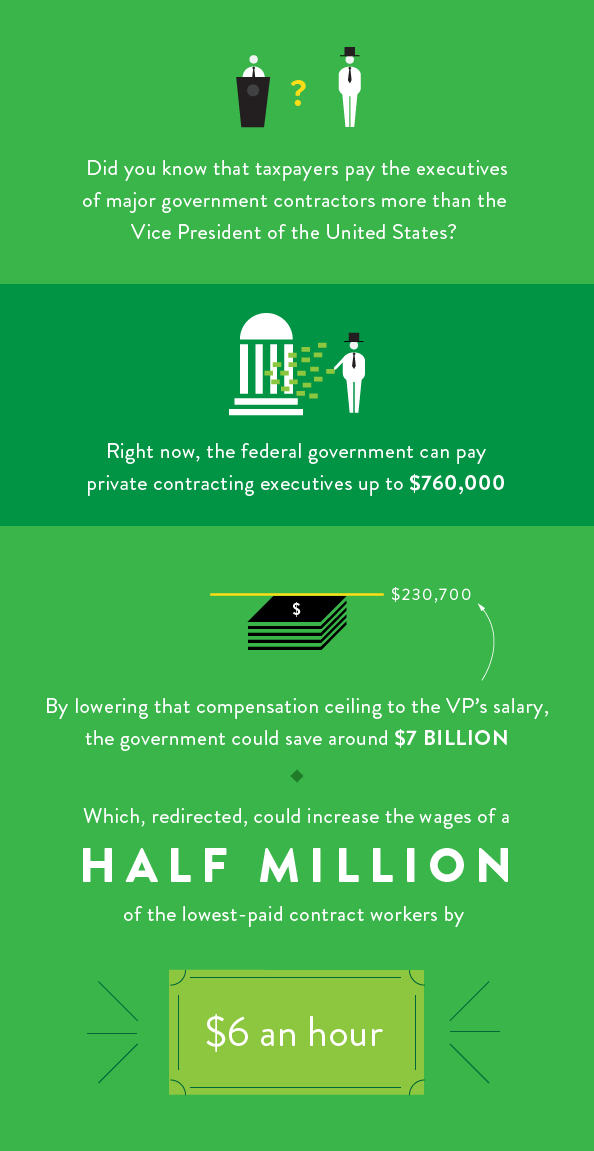 (Source: Demos)
(Source: Demos)
The debate over America’s federal budget is getting stale—and getting us nowhere, as the latest government shutdown depressingly reminds us. Political obsession over budget deficits has now morphed into legislative extortion.
Today, more than ever, we need to refocus the federal “tax and spend” debate—from deficits to inequality. Two researchers from the New York think tank Demos are trying. They’ve released a new report that zones in on the no-man’s-land between the public and private sector that has left hundreds of thousands of Americans poor and a lucky few fabulously rich.
| Executives at private companies with federal contracts are getting rich off our tax dollars —at the expense of their low-wage workers. But we can turn the tables. Here’s how. |
This no-man’s-land has expanded enormously over recent years as the federal government has contracted out and privatized one public service after another.
Those janitors who clean the Smithsonian museums? Those cooks at military bases? Those programmers writing software for Medicare? More and more of the workers who keep our government running work for private contractors.
And many of these workers, note Demos analysts Robert Hiltonsmith and Amy Traub, don’t make much at all in the way of compensation. About 560,000 Americans employed by contractors have jobs that pay $12 an hour or less.
Meanwhile, the executives who run these companies are doing quite well—thanks to our tax dollars. The federal government reimburses private firms for up to $763,039 of the executive compensation they lay out, a figure that will shortly rise to $950,000 under the formula current federal law sets out.
Let’s place this $763,039 in context. The President of the United States only makes $400,000. Our Vice President pulls in $230,700.
In other words, our tax dollars are compensating private contractor executives at a level three times higher than Joe Biden’s paycheck.
These dollars add up. In their new Demos study, Underwriting Executive Excess, researchers Hiltonsmith and Traub calculate that the federal government is now spending $20.8 to $23.9 billion annually, overall, for the compensation of top private contractor executives.
Out of this sizeable stash of tax dollars, the pair estimates, $6.97 to $7.65 billion is going to private contractor executive pay that exceeds $230,700 a year.
In short, Hiltonsmith and Traub note, “we are bankrolling the paychecks of already-wealthy executives instead of supporting more livable wages for American workers struggling to get by.”
We could solve this problem, the two quickly add, quite simply—just by lowering the top contractor pay reimbursement level from the current $763,039 to $230,700, the current vice-presidential payout.
Taking this course would save enough tax dollars, the new Demos research indicates, to give a $6 an hour raise to the 560,000 federal contractor workers who currently make $12 or less an hour. Legislation calling for this simple step, the Commonsense Contractor Compensation Act of 2013, is already pending.
But we could go even further to leverage the power of the public purse toward a more equal America. The CEOs of the biggest federal contractors, executives like Lockheed Martin CEO Robert Stevens, don’t take the bulk of their personal pay directly from the federal government. Their subsidy comes indirectly.
The companies these executives run owe their robust profitability to federal contracts. This profitability keeps corporate share prices high. Stock options and other stock awards translate these high share prices into whopping executive windfalls. Lockheed’s Stevens took home $23.8 million last year.
The alternative? The federal government could deny contracts—and corporate tax breaks as well—to companies that pay their top executives over 25 or 50 times the pay of their most typical workers, the corporate pay range from the 1950s through the early 1980s. Our contemporary gap: 354 times.
The 2010 Dodd-Frank Wall Street Reform and Consumer Protection Act already requires America’s corporations to annually disclose the ratio between their CEO and median worker pay. The Securities and Exchange Commission is now taking public comment on a new rule designed to implement this mandate, and, if things go smoothly, this rule will kick into effect sometime next year.
Congress, with annual ratio disclosure in place, could then easily link federal contracts to corporate pay equity.
The federal government, we ought to keep in mind, already denies our tax dollars to companies with employment practices that discriminate on the basis of race or gender. We’ve decided, as a society, not to subsidize racial or gender inequality. Why should we subsidize economic inequality?
Sam Pizzigati is an Associate Fellow at the Institute for Policy Studies and editor of Too Much: A Commentary on Excess and Inequality. His latest book is The Rich Don’t Always Win: The Forgotten Triumph over Plutocracy that Created the American Middle Class.




0 Comments